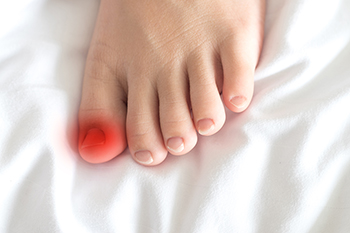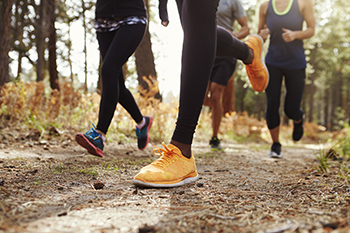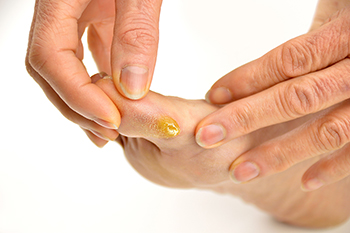Items filtered by date: July 2024
Definition and Complications of Ingrown Toenails

An ingrown toenail occurs when the edge or corner of a toenail grows into the surrounding skin, leading to pain, redness, and swelling. Causes can include improper nail trimming, wearing tight-fitting shoes, or sustaining foot trauma. If left untreated, ingrown toenails can escalate, causing infection. Bacteria can enter through the broken skin, leading to pus formation and further inflammation. In severe cases, untreated infections may spread beyond the toe, causing cellulitis or even a bone infection. Chronic ingrown toenails can also lead to recurrent pain and discomfort, affecting daily activities. Proper toenail care, including trimming nails straight across and wearing well-fitted shoes, can help to prevent ingrown toenails. If you have developed an ingrown toenail, it is suggested that you consult a podiatrist who can offer safe and effective treatment.
Ingrown toenails can become painful if they are not treated properly. For more information about ingrown toenails, contact one of our podiatrists of Nola Sole Podiatry. Our doctors can provide the care you need to keep you pain-free and on your feet.
Ingrown Toenails
Ingrown toenails occur when a toenail grows sideways into the bed of the nail, causing pain, swelling, and possibly infection.
Causes
- Bacterial infections
- Improper nail cutting such as cutting it too short or not straight across
- Trauma to the toe, such as stubbing, which causes the nail to grow back irregularly
- Ill-fitting shoes that bunch the toes too close together
- Genetic predisposition
Prevention
Because ingrown toenails are not something found outside of shoe-wearing cultures, going barefoot as often as possible will decrease the likeliness of developing ingrown toenails. Wearing proper fitting shoes and using proper cutting techniques will also help decrease your risk of developing ingrown toenails.
Treatment
Ingrown toenails are a very treatable foot condition. In minor cases, soaking the affected area in salt or antibacterial soaps will not only help with the ingrown nail itself, but also help prevent any infections from occurring. In more severe cases, surgery is an option. In either case, speaking to your podiatrist about this condition will help you get a better understanding of specific treatment options that are right for you.
If you have any questions please feel free to contact our office located in New Orleans, LA . We offer the newest diagnostic and treatment technologies for all your foot and ankle needs.
Preventive Training for Running Injuries

Preventing running injuries involves a combination of smart training techniques and maintaining overall strength. Gradually increasing mileage and intensity helps avoid overuse injuries by allowing the body to adapt to new demands. Incorporating rest days into the training schedule gives muscles time to recover and reduce fatigue. Strength training, especially for the core and lower body, enhances stability and reduces strain on joints. Proper warm-ups and cool-downs, including dynamic stretching, prepare the body for running and aid in recovery. Listening to the body and addressing any pain or discomfort promptly can prevent minor issues from becoming serious injuries. Wearing well-fitted, supportive footwear tailored to individual running styles also plays a crucial role. Foot and ankle injuries can be common and will hinder running ability. If you have sudden or chronic foot pain from running, it is suggested that you contact a podiatrist who can offer you effective treatment and running prevention injury methods.
Exercising your feet regularly with the proper foot wear is a great way to prevent injuries. If you have any concerns about your feet, contact one of our podiatrists of Nola Sole Podiatry. Our doctors will treat your foot and ankle needs.
How to Prevent Running Injuries
Many common running injuries are caused by overuse and overtraining. When the back of the kneecap starts wearing out and starts causing pain in your knee, this is commonly referred to as runner’s knee. Runner’s knee is a decrease in strength in your quadriceps and can occur if you’re not wearing properly fitted or supporting shoes. To prevent runner’s knee, focusing on hip strengthening is a good idea, as well as strengthening your quads to keep the kneecaps aligned.
What Are Some Causes of Running Injuries?
- One cause of a common running injury is called iliotibial band syndrome.
- Plantar fasciitis is also another common injury.
- Stress fractures can occur from overtraining, lack of calcium, or even your running style.
Best Ways to Prevent Running Injuries
- Wear footwear that fits properly and suits your running needs.
- Running shoes are the only protective gear that runners have to safeguard them from injury.
- Make a training schedule. Adding strengthening exercises as well as regular stretching can help keep you strong and limber and can lessen the possibility of injuries.
- Stretching keeps muscles limber; this will help you gain better flexibility.
If you have any questions please feel free to contact our office located in New Orleans, LA . We offer the newest diagnostic and treatment technologies for all your foot and ankle needs.
Heel Pain Can Be Treated!
Battling Foot Problems From Diabetes

Diabetes can have a profound impact on foot health, leading to complications such as nerve damage and poor circulation. These issues increase the risk of developing sores, infections, and even severe conditions that may necessitate amputation. Daily foot checks are essential for early detection of cuts, blisters, or signs of infection. Wearing appropriate socks is also important. Choose socks that wick away moisture, fit well, and are free of seams to prevent irritation. Selecting the right footwear is also important. Ensure that your shoes fit well, but also leave some room for toe movement to avoid pressure points. It's also advisable to avoid walking barefoot, even indoors, to protect against unnoticed injuries. Diabetic patients with venous insufficiency or swelling may benefit from wearing compression socks but should consult their podiatrist for the best options. Good foot hygiene, including washing with warm water and drying thoroughly, helps prevent fungal infections. Keeping toenails trimmed straight across can prevent ingrown toenails, which are another potential source of infection. Regular visits to a podiatrist can help manage and monitor foot health, preventing minor issues from escalating. If you experience diabetic foot pain, it is suggested that you schedule an appointment with a podiatrist for an exam and treatment options.
Diabetic foot care is important in preventing foot ailments such as ulcers. If you are suffering from diabetes or have any other concerns about your feet, contact one of our podiatrists from Nola Sole Podiatry. Our doctors can provide the care you need to keep you pain-free and on your feet.
Diabetic Foot Care
Diabetes affects millions of people every year. The condition can damage blood vessels in many parts of the body, especially the feet. Because of this, taking care of your feet is essential if you have diabetes, and having a podiatrist help monitor your foot health is highly recommended.
The Importance of Caring for Your Feet
- Routinely inspect your feet for bruises or sores.
- Wear socks that fit your feet comfortably.
- Wear comfortable shoes that provide adequate support.
Patients with diabetes should have their doctor monitor their blood levels, as blood sugar levels play such a huge role in diabetic care. Monitoring these levels on a regular basis is highly advised.
It is always best to inform your healthcare professional of any concerns you may have regarding your feet, especially for diabetic patients. Early treatment and routine foot examinations are keys to maintaining proper health, especially because severe complications can arise if proper treatment is not applied.
If you have any questions please feel free to contact our office located in New Orleans, LA . We offer the newest diagnostic and treatment technologies for all your foot and ankle needs.
Pronation Can Affect Your Running

Pronation is the natural side-to-side movement of the foot during walking or running. It is essential for shock absorption and navigating uneven surfaces. However, problems arise when this movement is excessive. Overpronation, where the foot rolls too far inward, can cause prolonged ground contact and increased stress on the leg's alignment. This may lead to injuries like plantar fasciitis, shin splints, and knee pain. Conversely, underpronation, or insufficient inward roll, causes the foot to remain rigid, failing to absorb shock effectively. This places undue stress on the outer edge of the foot, increasing the likelihood of stress fractures. Identifying pronation issues can often be done through a professional gait analysis conducted by a podiatrist. In some cases, a podiatrist might recommend custom orthotics to provide additional support and correct alignment issues. Selecting appropriate footwear and strengthening foot and ankle muscles can help manage pronation-related problems. If you experience foot pain linked to pronation, it is suggested that you make an appointment with a podiatrist for an exam and treatment.
If you have any concerns about your feet, contact one of our podiatrists from Nola Sole Podiatry. Our doctors can provide the care you need to keep you pain-free and on your feet.
Biomechanics in Podiatry
Podiatric biomechanics is a particular sector of specialty podiatry with licensed practitioners who are trained to diagnose and treat conditions affecting the foot, ankle and lower leg. Biomechanics deals with the forces that act against the body, causing an interference with the biological structures. It focuses on the movement of the ankle, the foot and the forces that interact with them.
A History of Biomechanics
- Biomechanics dates back to the BC era in Egypt where evidence of professional foot care has been recorded.
- In 1974, biomechanics gained a higher profile from the studies of Merton Root, who claimed that by changing or controlling the forces between the ankle and the foot, corrections or conditions could be implemented to gain strength and coordination in the area.
Modern technological improvements are based on past theories and therapeutic processes that provide a better understanding of podiatric concepts for biomechanics. Computers can provide accurate information about the forces and patterns of the feet and lower legs.
Understanding biomechanics of the feet can help improve and eliminate pain, stopping further stress to the foot.
If you have any questions please feel free to contact our office located in New Orleans, LA . We offer the newest diagnostic and treatment technologies for all your foot and ankle needs.
Severe Corns and Calluses on the Feet
 Severe calluses are thickened areas of skin that develop on the feet due to repeated pressure or friction. They often occur on the heels, soles, and sides of the feet. Corns are similar to calluses but are smaller, with a hard center surrounded by inflamed skin, typically forming on the toes. These conditions can happen as a result of wearing tight or ill-fitting shoes, high-heeled shoes, or abnormal gait patterns. Calluses look like rough, thick patches of skin, while corns appear as hard, round bumps. They can cause discomfort, pain, and tenderness, making walking difficult. Relief can consist of soaking the feet in warm water, using pumice stones or foot files to remove thickened skin, moisturizing, and wearing properly fitted shoes. Complications can arise if calluses and corns are left untreated, leading to skin ulcers or infections, especially in individuals with diabetes. If you suffer from these ailments, it is suggested that you schedule an appointment with a podiatrist who can effectively treat uncomfortable corns and calluses.
Severe calluses are thickened areas of skin that develop on the feet due to repeated pressure or friction. They often occur on the heels, soles, and sides of the feet. Corns are similar to calluses but are smaller, with a hard center surrounded by inflamed skin, typically forming on the toes. These conditions can happen as a result of wearing tight or ill-fitting shoes, high-heeled shoes, or abnormal gait patterns. Calluses look like rough, thick patches of skin, while corns appear as hard, round bumps. They can cause discomfort, pain, and tenderness, making walking difficult. Relief can consist of soaking the feet in warm water, using pumice stones or foot files to remove thickened skin, moisturizing, and wearing properly fitted shoes. Complications can arise if calluses and corns are left untreated, leading to skin ulcers or infections, especially in individuals with diabetes. If you suffer from these ailments, it is suggested that you schedule an appointment with a podiatrist who can effectively treat uncomfortable corns and calluses.
If you have any concerns regarding your feet and ankles, contact one of our podiatrists of Nola Sole Podiatry. Our doctors will treat your foot and ankle needs.
Corns: What Are They? and How Do You Get Rid of Them?
Corns can be described as areas of the skin that have thickened to the point of becoming painful or irritating. They are often layers and layers of the skin that have become dry and rough, and are normally smaller than calluses.
Ways to Prevent Corns
There are many ways to get rid of painful corns such as wearing:
- Well-fitting socks
- Comfortable shoes that are not tight around your foot
- Shoes that offer support
Treating Corns
Treatment of corns involves removing the dead skin that has built up in the specific area of the foot. Consult with Our doctors to determine the best treatment option for your case of corns.
If you have any questions please feel free to contact our office located in New Orleans, LA . We offer the newest diagnostic and treatment technologies for all your foot and ankle needs.

